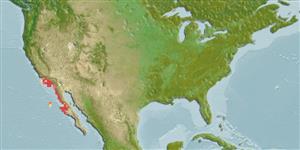>
Ovalentaria/misc (Various families in series Ovalentaria) >
Pomacentridae (Damselfishes) > Microspathodontinae
Etymology: Hypsypops: Greek, hypsy, hypops = high + Greek, ops = appearance (Ref. 45335).
More on author: Girard.
Environment: milieu / Zona climática / intervalo de profundidade / distribution range
Ecologia
marinhas associadas(os) a recifes; não migratória; intervalo de profundidade 0 - 30 m (Ref. 9334). Subtropical; 37°N - 27°N, 122°W - 114°W
Eastern Central Pacific: Monterey Bay in California, USA to southern Baja California and Guadalupe Island (off northern central Baja California) in Mexico.
Tamanho / Peso / Idade
Maturidade: Lm ? range ? - ? cm
Max length : 30.0 cm SL macho/indeterminado; (Ref. 7247); idade máx. registrada: 57 anos (Ref. 52465)
Descrição suscinta
Chaves de identificação | Morfologia | Morfometria
Espinhos dorsais (total) : 12; Raios dorsais (total) : 16 - 17; Espinhos anais: 2; Raios anais : 13 - 14.
Body shape (shape guide): short and / or deep; Cross section: compressed.
Adults occur over rocky bottom in clear water, often near crevices and small caves, occasionally in kelp. Adults defend a home territory. Feed mainly on attached invertebrates. Oviparous, distinct pairing during breeding (Ref. 205). Eggs are demersal and adhere to the substrate (Ref. 205). Males guard and aerate the eggs (Ref. 205). Have been reared in captivity (Ref. 35420).
Ciclo de vida ou comportamento de acasalamento
Maturidade | Reprodução | Desova | Ovos | Fecundidade | Larvas
Oviparous, distinct pairing during breeding (Ref. 205). Male clears a sheltered nest site; female deposits eggs, which male guards (Ref. 2850).
Allen, G.R., 1991. Damselfishes of the world. Mergus Publishers, Melle, Germany. 271 p. (Ref. 7247)
Status na Lista Vermelha da UICN (Ref. 130435: Version 2025-1)
Ameaça para os humanos
Harmless
Uso pelos humanos
Ferramentas
Relatórios especiais
Baixar XML
Fontes da internet
Estimates based on models
Preferred temperature (Ref.
123201): 15.3 - 19.2, mean 17.5 °C (based on 48 cells).
Índice de diversidade filogenética (Ref.
82804): PD
50 = 1.0000 [Uniqueness, from 0.5 = low to 2.0 = high].
Bayesian length-weight: a=0.01995 (0.00910 - 0.04376), b=2.99 (2.80 - 3.18), in cm total length, based on LWR estimates for this (Sub)family-body shape (Ref.
93245).
Nível Trófico (Ref.
69278): 3.5 ±0.19 se; based on food items.
Generation time: 6.5 (5.8 - 7.3) years. Estimated as median ln(3)/K based on 28
growth studies.
Resiliência (Ref.
120179): Baixo, tempo mínimo de duplicação da população 4,5 - 14 anos (tmax=20; tm=5).
Fishing Vulnerability (Ref.
59153): Moderate to high vulnerability (51 of 100).
🛈
Nutrients (Ref.
124155): Calcium = 31.5 [13.7, 58.8] mg/100g; Iron = 0.521 [0.293, 0.911] mg/100g; Protein = 19.1 [17.9, 20.3] %; Omega3 = 0.148 [0.084, 0.258] g/100g; Selenium = 12.9 [6.1, 28.0] μg/100g; VitaminA = 48.5 [12.4, 190.6] μg/100g; Zinc = 0.866 [0.555, 1.315] mg/100g (wet weight);
